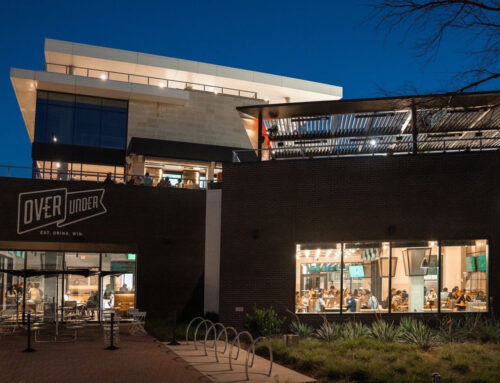It is becoming clear the highly-touted redevelopment of the old Dr Pepper building on Mockingbird by owner Dal-Mac Investment Corp. is going to take a somewhat different shape.
Knowledgeable insiders report that leases with originally proposed “anchor” tenants, including Barnes & Noble bookstores, won’t come to fruition.
Real estate and retailing professionals say retail isn’t the growth sector it was a couple of years ago, with slow sales nationally, and fierce competition with and among the so-called “category-killers” or “big-box” retailers.
While Dal-Mac is looking closely at alternative retail configurations, all of which would try to preserve at least the central Art Moderne façade, the owners also have been approached about converting the site to office use, hopefully while still keeping the façade.
The existing plan was the result of untold hours of work on the part of Dal-Mac, the City, historic preservationists and neighborhood representatives.
No one will be pleased with the prospect of having to “go back to the drawing board,” literally and figuratively, but all during this process everyone has recognized the key role that market forces and conditions would play in whatever happened to the landmark building.
The hope here is that Dal-Mac will permit the same level of involvement as before on the part of stakeholders in the area.
Traffic Study Pits ‘M’ Street Neighbors Against Each Other
The ongoing East Dallas Neighborhood Traffic Management Study is encountering slow-downs as various interest groups jockey for position.
Inevitably during such an important undertaking (which affects Mockingbird, Greenville, Ross, Henderson and Central), the emerging issues pit not only neighborhood and business interests, but potentially neighborhoods against each other and even factions within neighborhoods.
The prime example of the latter is in Greenland Hills, where residents on McCommas and Monticello long have wished for a reduction in east-west “cut-through” traffic, hence the speed bumps installed a few years ago.
However, as long as the McCommas and Monticella bridges crossing Central remained open, actual closing of the two streets was never seriously at issue.
Now, however, the issue is hotter than ever with the advent of the traffic study, the looming possibility of building a sound wall along the Central frontage road, and the approaching decision of where, if anywhere, sound wall breaks should be located.
Within the Greenland Hills neighborhood, the group’s leadership, many of whom live on the two streets, are pushing for closure of the two streets at Central.
Many others in Greenland Hills and in the Vickery Place neighborhood just to the south feel this plan would result in more north-south traffic through Vickery Place.
As always in these situations, “process” is very important, and feedback from some in Greenland Hills indicates some dissatisfaction with the openness of discussion of the group’s position.
Add to this the concern in Vickery Place, the potential for disagreement with neighborhoods east of Greenville, and the fact that the recently included Cochran Heights neighborhood wants the sound wall extended to Fitzhugh, but is unlikely to get it, and it’s easy to see the situation in a state of flux.
City staffers and business and neighborhood leaders obviously have a lot of work ahead of them to reach sensible compromises and to sell these compromises to their constituents, bearing in mind the truism that those who aren’t at the negotiating talks won’t have any stake in any proposed solutions.
Maybe U.S. negotiator Richard Holbrooke will be available once he completes his work in the Balkans.
“S Curve” Adopted for Haskell
Finally, the City Council has adopted the somewhat controversial “S-curve” alignment for the reconstruction of Haskell Avenue from Central to Fair Park.”
The adopted plan avoids the need to move buildings belonging to several major institutions but displeases others who may find themselves in the bulldozer’s path.
As with everything in the public arena, however this may not be the last word, as the Council will continue to study the feasibility of moving some buildings in order to straighten the “S-curve” more in conformance with the vision of noted architect James Pratt, who first envisioned the project.





